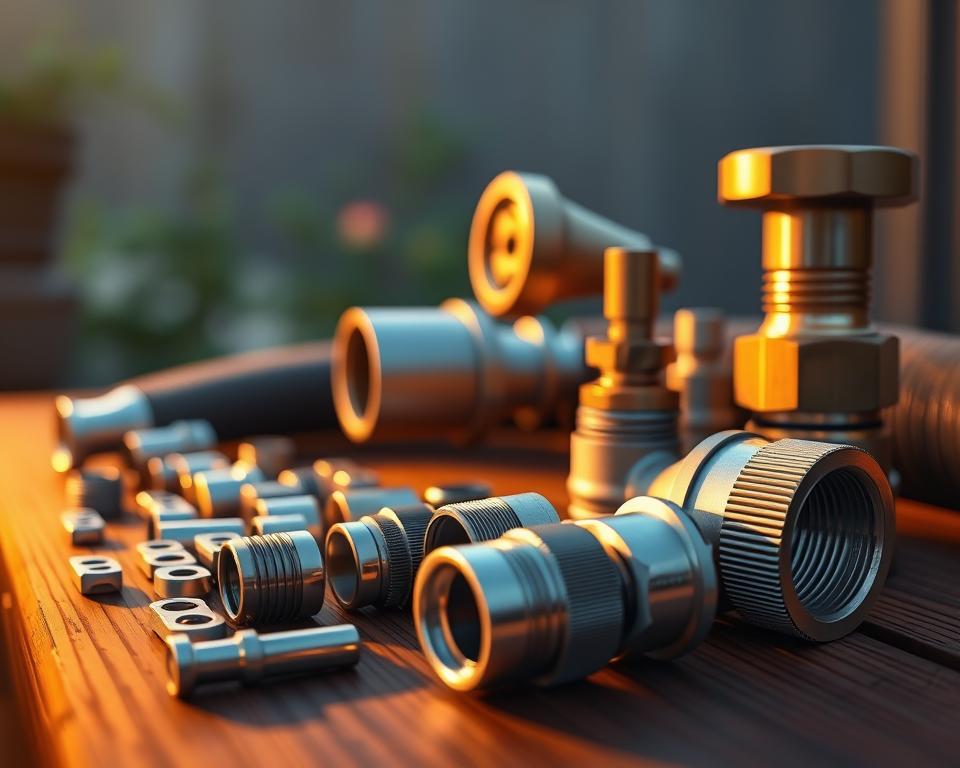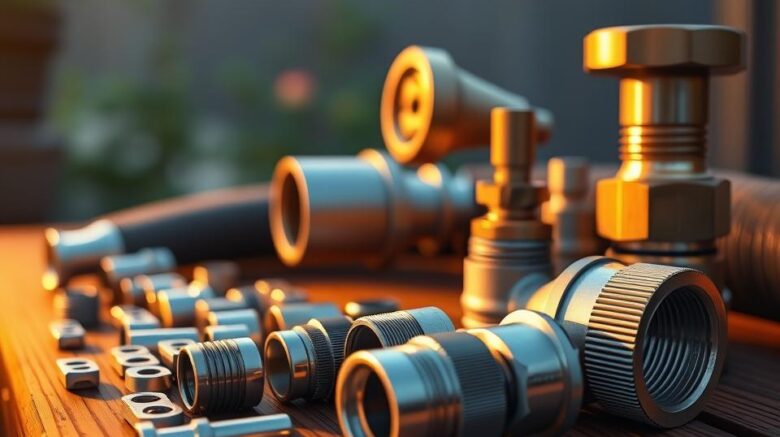Essential Yard Accessories: Standard Garden Hose Fittings
Puzzled by leaks and weak flow in your garden hose setup? Tiny what size is garden hose thread connectors—your standard garden hose fittings—often cause leaks and poor performance. They preserve flow, guard against leaks, and support a healthy yard.
Installation Parts Supply reports that 67% of hose breakdowns are caused by bad or improper connectors. Choosing suitable fittings is key for both simple sprinklers and elaborate irrigation rigs.
Most connectors follow the ANSI ¾”-11.5 NH thread size, ensuring broad compatibility. Use this guide to pick sturdy materials, verify PSI ratings, and sidestep mistakes. Enhance your watering gear confidently!
Summary Highlights
- Proper fittings prevent leaks and improve water efficiency.
- 3/4″ ANSI ¾”-11.5 NH threads ensure compatibility everywhere.
- Count on Installation Parts Supply for trusted fittings.
- Durability hinges on chosen materials and pressure ratings.
- 67% of hose breakdowns begin at bad fittings.

Choosing the Correct Fittings: Why It Matters
Leaky fittings can dump far more water than you’d expect. Low-grade fittings lead to 40% of water loss in watering setups. That’s like leaving the faucet running while you’re not even using it!
Mismatched parts can drop pressure by up to 20%. Sprinkler reach can suffer significantly. Pro tip: Keep pressure-washer hoses under 50 feet for best flow.
Don’t overlook safety issues. High-pressure blasts from bad fittings can harm people or gear. Their reinforced, pressure-rated fittings stop dangerous ruptures.
Durability matters too. Weatherproof materials extend service life in tough climates. Quick-connect fittings often crack in frost—check them each season.
A user reported a 35% increase in sprinkler coverage after switching fittings. Good connectors conserve water, run better, and save cash.
Inside Your Garden Hose Fittings
What makes some hose connections last for years while others fail in months? It comes down to parts like ferrules, seals, and threads. Every piece helps stop leaks and keep flow steady.
Ribbed collars hold hoses firmly in place. Smooth ferrules excel under pressure. Barbed ferrules secure hoses but risk flow restriction if crooked.
Washers are the unsung heroes. Most drips trace back to a bad washer. Press it firmly into the groove before tightening—this simple step saves water and frustration.
Thread depth affects sealing. Male ends should screw in fully to female counterparts. Even slight gaps let water escape. Choose one-piece fittings for rugged use—they endure longer than two-piece types.
Installation Parts Supply’s patented anti-kink collar adds durability. It prevents sharp bends that cause leaks. Check and replace O-rings quarterly for best results.
A quality fitting outperforms and outlasts. Pick fittings to suit your setup and prevent headaches.
Which Hose Fitting Suits You?
Stumped by different hose fitting styles? Here’s the lowdown. Quick-disconnects, regulators, and more each have their own benefits.
Snap-on disconnects speed tool changes. Plastic for easy tasks; brass for tougher, higher-PSI work. Their frost-proof valves resist cracking in cold—winter ready.
Swivel connectors let your hose pivot 270° to avoid kinks. Use Y-splitters to feed two hoses at once. Commonly used for simultaneous patio washing and plant watering.
Regulators keep your sprinklers safe from pressure spikes. They stabilize flow when upstream PSI jumps. Refer to the table for cost vs. performance:
| Type | Material | Cost | Flow Rate (GPM) |
|---|---|---|---|
| Quick-Connect | Plastic | $1.50 | 4.2 |
| Quick-Connect | Brass | $8.00 | 5.1 |
| Y-Splitter | Aluminum | $6.50 | 3.8 (per outlet) |
For heavy-duty use, camlock couplings provide leak-proof seals. Camlock SS bodies fight rust and chemical attack. Stick to ¾” threads for home hoses.
Always have replacement washers handy. A worn seal can reduce water pressure by 20% before you even notice the drip.
Materials Matter: Brass, Plastic, or Aluminum?
Choose materials carefully for performance and safety. Brass boasts a 500 PSI capacity; plastic about 150 PSI. Use lead-free brass for potable water to comply with Prop 65.
Aluminum outlasts plastic in sun exposure. Metal handles extreme temps (-20°F to 180°F), but plastic cracks in freezing weather. Their brass-aluminum combo fittings blend strength and lightness.
When choose plastic? Seasonal drip lines and temporary hoses. Refer to the table for price and PSI specs:
| Type | Material | Cost | Max PSI |
|---|---|---|---|
| Coupler | Plastic | $4 | 150 |
| Coupler | Brass | $12 | 500 |
| Hybrid | Brass-Aluminum | $9 | 400 |
For longevity, match *components* to your climate and pressure needs. A $12 brass fitting often outlasts three plastic replacements—saving money long-term.
Hose Diameter Guide
Hose diameter affects pressure and reach. ¾” hoses handle roughly 5 gallons per minute for good coverage. Smaller ⅝-inch lines max out at 3 GPM, ideal for gentle watering.
Pressure drops down a long hose. Count on roughly 1 PSI per foot lost. Pressure washers need 50-foot maximums to maintain strong flow. Bridge varying hose sizes leak-proof with their adapters.
How length affects sprinklers:
- 25 ft: Perfect for small patios or container gardens.
- 50 ft: Covers medium lawns (up to 1,500 sq ft).
- Needs more PSI to cover large areas.
Large-scale irrigation uses 1″ connectors. They deliver extra GPM for big jobs. See the chart for diameter vs. flow:
| Diameter | Flow Rate (GPM) | Best For |
|---|---|---|
| ⅝ inch | 3 | Drip irrigation, small gardens |
| ¾ inch | 5 | Sprinklers, car washing |
| 1 inch | 7+ | Agriculture, large properties |
Plan your watering specs before you buy. 3/4″ hoses fit typical homes, but long runs need careful planning. Adapters make connecting different gear easy.
Fitting Compatibility & PSI Ratings
Why does your setup fail when pressure surges hit? The answer lies in PSI ratings. A 150 PSI fitting works under steady flow but may fail at 300+ PSI surges.
Burst rating exceeds working rating. A 300 PSI burst spec handles spikes, not sustained flow. Their industrial fittings endure surges—perfect for pressure washers and farms.
Sun-warmed hoses increase PSI. Every 10°F rise adds 5–10 PSI in a closed hose. Add loops to let hoses expand safely.
Key Pressure Ratings Compared
| Rating | Best For | Burst Strength |
|---|---|---|
| 150 PSI | Residential sprinklers | 450 PSI |
| 300 PSI | Irrigation systems | 900 PSI |
| 600 PSI | Industrial use | 1,800 PSI |
Thread mismatches cause 30% of leaks. Use adapters to bridge sizes—but *make sure* they’re rated for your system’s PSI. One farm’s switch to 300 PSI brass fittings reduced leaks by 40%.
Checklist for Mixing Fittings
- Match thread types (e.g., ANSI ¾”-11.5 NH).
- Inspect washers for cracks before reusing.
- Verify PSI rating on older fittings.
- Swap out rusty or bent fittings.
Your hose and accessories define your pressure demands. Good planning stops fitting disasters.
Maintaining Your Fittings
A bit of care preserves seal integrity. Perform annual checks for wear, rust, and looseness. Snug up loose fittings ASAP.
Leak testing is simple. Attach your setup to a *faucet*, turn on the water, and look for drips. Start at the fitting junctions. Their gauge reveals unseen drips.
For freezing climates, winterize your system. Empty hoses and stow inside. Use insulated covers on outdoor spigots. It avoids freeze damage to your watering system.
Their installation toolkit includes:
- Adjustable wrenches for secure tightening
- Thread seal tape to stop slow leaks
- Spare washers and a guide sheet
Replace washers every 6 months. Use correct-size washers—wrong ones cause 30% of leaks. Have spares on hand for quick fixes.
Hang hoses away from direct sun. UV rays weaken materials over time. A hanging rack or reel keeps them tangle-free and ready for action.
Can’t stop a drip? Do this:
- Brush threads clean of grit
- Apply plumber’s grease to stiff O-rings
- Replace damaged washers right away
Wrap-Up: Find Your Ideal Fitting
Get the proper fittings to transform your hose setup. Pick brass or plastic, quick-connect or swivel to fit your usage.
Investing in good fittings is worth it. Brass fittings often pay for themselves in longevity. Installation Parts Supply backs its parts with warranties—peace of mind included.
Refer to this guide:
- Check pressure ratings before buying
- Inspect washers every season
- Store indoors during freezing temps
New smart fittings with leak detectors are coming soon. Until then, consult experts to get job done right. Your garden hose system deserves the best!
